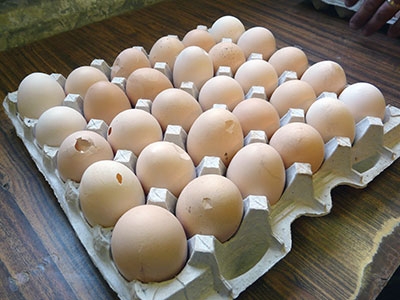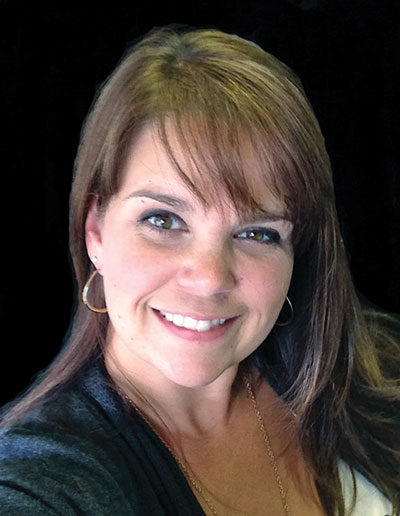
Shell Quality
By by Lisa Hodgins M.Sc. Monogastric Nutritionist New Life Mills A division of Parrish & Heimbecker Limited
Features Production Turkeys Poultry Production ProductionImpact of breeder nutrition
 Eggs that are unacceptable (above) and acceptable (below) as settable. Poor shell quality can lead to large economic losses due to the decrease in production of settable eggs
Eggs that are unacceptable (above) and acceptable (below) as settable. Poor shell quality can lead to large economic losses due to the decrease in production of settable eggs
Maintaining shell quality in a breeder flock is a major focus for nutritionists and producers alike. Poor shell quality can lead to large economic losses as a result of a decrease in the production of settable eggs per hen. While there are many factors that influence shell quality, nutrition plays an important role in preventing cracks and other defects that may result in an egg being deemed unacceptable as a settable egg.
Calcium
Calcium is the first nutrient producers and nutritionists focus on when shell quality starts to deteriorate. Broiler breeder hens require about 4-5 grams of calcium per hen per day to maintain calcium balance and produce a good shell on their eggs. In today’s commercial breeder operations, hens are often fed a pelleted feed. A typical breeder ration balanced at 3.2% calcium with hens consuming 168 grams per bird results in the total intake of 5 grams of calcium per hen (168×0.032) and meets their daily requirement for calcium. The hiccup with this feeding strategy is that hens are typically fed early in the morning, and, as a result, they consume their calcium requirement before the egg is actually in the shell gland forming a shell. In mash and pelleted feeds, coarse limestone or oyster shell should be included in the diet. It is not incorporated into the pellet per se, but added to the feed after it has been manufactured. This will supply a component of the total calcium from a coarse source which is absorbed into the blood stream at a much slower rate.
Shell quality can be improved by broadcasting coarse calcium (limestone, oyster shell) in the afternoon onto the litter. This provides the hens’ with access to a calcium source at a time of day when the shell is actually forming, thereby improving shell quality. Broadcasting involves tossing handfuls of limestone/oyster shell out onto the shavings throughout the barn once a day. At the same time, it is important to avoid excessive use of limestone/oyster shell as we do not want it to build up in the litter if the hens do not consume all of it. Too much calcium can reduce shell quality, as it is known to cause pimpled and soft-shell eggs. Hens can safely be fed one gram per bird in the afternoon by way of broadcasting.
Vitamin D
Vitamin D plays a role in the function of calcium absorption and transport to the shell gland. Diets low in Vitamin D can cause shell quality to deteriorate because it reduces the absorption of calcium. Breeder diets are balanced with about 3,000-3,500 IU/kg of added vitamin D, which will meet the needs of the breeder hens. When shell quality does deteriorate, it is common practice to provide additional vitamin D in the form of Hy-D (25(OH)D3). Hy-DTM is a potent form of vitamin D that is highly available to the bird and promotes increased calcium absorption, thereby improving shell quality. Hy-DTM may be added to the feed or drinking water. Consult your nutritional advisor prior to supplementing Hy-DTMor other vitamin D3 products, as excessive intake can be harmful to the hens and shell quality.
Phosphorus
Phosphorus is another mineral that plays a role in shell quality. The correct calcium-to-phosphorus balance is critical in maintaining shell quality because the need for phosphorus is linked to the need for calcium. Phosphorus levels that are too high can cause shell quality to deteriorate because the high levels of phosphorus induce a calcium deficiency. When phosphorus levels are too low, we also see shell quality deteriorate because calcium metabolism is impaired. Nutritionists work diligently to ensure that the optimal level of phosphorus is provided in a diet. As a result, supplementing with additional phosphorus sources is not recommended without the direct involvement from your nutritionist.
Trace Minerals
Deficiencies in trace minerals such as copper, manganese and zinc may result in thinner, wrinkled or translucent shells. These nutrients are provided in your complete feed and are usually supplemented through the addition of a cocktail of different forms (oxide, sulfate, complexed trace minerals). In situations where shell quality is deteriorating, it is not uncommon to add additional trace minerals to the feed in the complexed form because they are known to have the highest biological availability.
Egg Size
As the breeder hen ages, egg size increases. However, the total amount of shell that covers that large egg stays the same. Consequently a bigger egg, with the same amount of shell automatically means thinner shells and more opportunities for that egg to be damaged. To address this, we sometimes use a phase feeding strategy to manipulate the diet to help control the size of the egg.
Egg size can be manipulated by adjusting the level of protein, amino acids and linoleic acid in the diet. Research has concluded that by reducing the total sulphur amino acids (methionine and cystine) the rate at which egg size increases can be slowed. If we can keep the eggs on the smaller side (65-68 grams), there is less surface area to cover, resulting in thicker shells that are less vulnerable to damage.
Conclusion
Shell quality problems can appear in any flock. However, nutritionists working with producers are able to manipulate various aspects of the diet in order to conquer the problem or at least minimize the impact. This can be accomplished through adjustments to the calcium level in the feed, the calcium source, vitamins, trace minerals and through controlling egg size. The producer, with his/her nutrition team, can develop a strategy to achieve the best shell quality possible to maximize the number of settable eggs and hatch the healthiest and best quality chick possible.
 |
Lisa hodgins – The New Life Mills Monogastric Nutritionist discusses the important role of nutrition on the shell quality of breeder eggs
Print this page